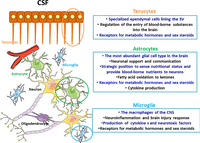Glial cells and energy balance
- Pilar Argente-Arizón1,
- Santiago Guerra-Cantera1,
- Luis Miguel Garcia-Segura2,
- Jesús Argente1 and
- Julie A Chowen1⇑
- 1Departments of Pediatrics & Pediatric Endocrinology, Hospital Infantil Universitario Niño Jesús, Instituto de Investigación La Princesa, Department of Pediatrics, Universidad Autónoma de Madrid, CIBEROBN, Instituto de Salud Carlos III, Madrid, Spain
- 2Instituto Cajal, Consejo Superior de Investigaciones Científicas (CSIC), Madrid, Spain
- Correspondence should be addressed to J A Chowen; Email: julieann.chowen{at}salud.madrid.org
-
Figure 1
Summary of some of the most relevant functions performed by glial cells in metabolic control. Graphic illustration of the various cell types found in the central nervous system (CNS). Glial cells are the most abundant cell type in the CNS and are involved in both physiology and pathophysiology of energy homeostasis. Amongst glial cells, microglia, astrocytes and tanycytes have been most clearly implicated in metabolic control. 3V, third ventricle; CNS, central nervous system; CSF, cerebrospinal fluid.
- © 2017 Society for Endocrinology












